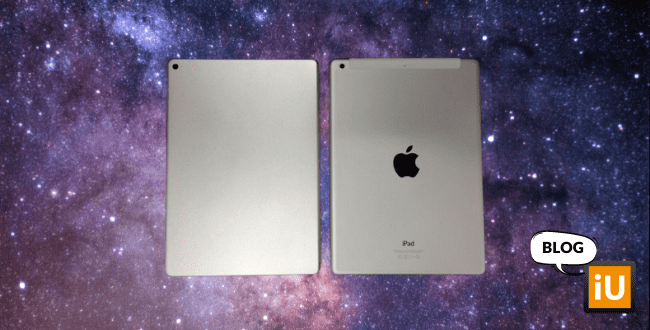03/01/2019

Differences between iPad Air 1 and iPad Air 2
In 2010, Apple announced the first iPad. Since then, various iPad models have been released, including the iPad Air (2013) and the iPad Air 2 (2014). These lightweight tablets are easy to use and ideal for everyday use. But what exactly is the difference between the two iPads? You’ll read all about it in this blog article.
One of the differences you’ll notice most is the processor. A strong processor ensures you don’t have to wait long for apps to open, games to load quickly, or that the display doesn’t lag. The iPad Air 2 is equipped with an A8X processor, the big brother of the A7 processor found in the iPad Air 1. Both processors perform nearly the same. Watching a video, sending a message, or playing a game can be done smoothly on both devices. However, with prolonged use of graphically intensive apps, such as large video games or photo editing software, the A8X will be noticeably faster with fewer hiccups.
Another difference is the coprocessor in both devices. The M8 Motion is more accurate than the M7 Motion in the iPad Air 1, especially noticeable in apps and games that use motion-based actions. Steering in a racing game, tracking steps, or using a compass are all applications that benefit from a better coprocessor.
The iPad Air 2 has double the RAM compared to the iPad Air 1, increasing from 1GB to 2GB. RAM allows apps to load into memory so that the processor can execute them. With 1GB, your device will perform fine, but some apps may need to be closed occasionally. With 2GB, you can have multiple apps open at the same time and run larger apps.
The iPad Air 2 also features an additional function: the barometer. This technology measures air pressure and provides relative altitude changes through location data. The barometer is integrated into the device, and you can view the measurements in Apple’s weather app. This feature is especially useful if you spend a lot of time outdoors, like during long forest walks or mountain hikes.
Below is a table with the technical specifications of both the iPad Air 1 and iPad Air 2.
In addition to the higher megapixel count, the iPad Air 2 has features not available on the iPad Air 1. These include HDR, which enhances nighttime photos, and improved light sensitivity, resulting in brighter and clearer images. Additionally, the camera's video function has a slow-motion mode, perfect for capturing memorable moments from a sports event, pet antics, or other moving scenes.
Whether to choose the iPad Air 1 or 2 depends on your needs and how you plan to use the tablet. For long-term and intensive use, we recommend purchasing the iPad Air 2, given its better processing speed. If this doesn’t matter much to you, then consider whether the additional benefits justify the higher price.
Our advice: first, determine what you will use the device for and how much it will cost. Only then should you choose the type of Apple tablet you want to purchase.
Appearance
At first glance, the iPad Air and iPad Air 2 look exactly alike. Both devices feature rounded corners, a metal back, and a reflective screen. The screen size (2,048 x 1,536 pixels) remains the same. However, the screen of the iPad Air 2 is different because it has an anti-reflective coating. This coating reduces reflections on the screen. In addition to the updated screen, the iPad Air 2 is lighter than its predecessor. This is thanks to the thinner design; the iPad Air 2 is 6.1 mm thick, which is 19% thinner than the iPad Air 1.Technical
The most noticeable technical difference is the addition of Touch ID in the home button of the iPad Air 2. Touch ID uses fingerprint technology, allowing users to unlock their device and authorize apps and passwords with their fingerprint.One of the differences you’ll notice most is the processor. A strong processor ensures you don’t have to wait long for apps to open, games to load quickly, or that the display doesn’t lag. The iPad Air 2 is equipped with an A8X processor, the big brother of the A7 processor found in the iPad Air 1. Both processors perform nearly the same. Watching a video, sending a message, or playing a game can be done smoothly on both devices. However, with prolonged use of graphically intensive apps, such as large video games or photo editing software, the A8X will be noticeably faster with fewer hiccups.
Another difference is the coprocessor in both devices. The M8 Motion is more accurate than the M7 Motion in the iPad Air 1, especially noticeable in apps and games that use motion-based actions. Steering in a racing game, tracking steps, or using a compass are all applications that benefit from a better coprocessor.
The iPad Air 2 has double the RAM compared to the iPad Air 1, increasing from 1GB to 2GB. RAM allows apps to load into memory so that the processor can execute them. With 1GB, your device will perform fine, but some apps may need to be closed occasionally. With 2GB, you can have multiple apps open at the same time and run larger apps.
The iPad Air 2 also features an additional function: the barometer. This technology measures air pressure and provides relative altitude changes through location data. The barometer is integrated into the device, and you can view the measurements in Apple’s weather app. This feature is especially useful if you spend a lot of time outdoors, like during long forest walks or mountain hikes.
Below is a table with the technical specifications of both the iPad Air 1 and iPad Air 2.
| Specification | iPad Air 1 | iPad Air 2 |
| Dimensions in mm | 240 x 169.5 x 7.5 | 240 x 169.5 x 6.1 |
| Weight (WiFi model) | 469 grams | 437 grams |
| Weight (WiFi + 4G) | 478 grams | 444 grams |
| Screen diagonal | 9.7" / 24.6 cm | 9.7" / 24.6 cm |
| Resolution in pixels | 2048 x 1536 | 2048 x 1536 |
| Pixel density in PPI | 264 | 264 |
| Processor | A7 | A8X Fusion |
| Coprocessor | M7 Motion | M8 Motion |
| RAM | 1GB | 2GB |
| Storage | 12GB, 32GB, 64GB, 128GB | 12GB, 32GB, 64GB, 128GB |
| Rear camera | 5 megapixel | 8 megapixel (dual) |
| Front camera | 1.2 megapixel | 1.2 megapixel (dual) |
| Battery life normal use | approx. 10 hours | approx. 10 hours |
Camera
One thing that stands out in the specifications is the camera. Both devices have a 1.2MP front camera, but the iPad Air 2 features an 8MP rear camera, compared to the iPad Air 1’s 5MP rear camera. This improvement is particularly noticeable when taking close-up photos or pictures in low light. Images and videos will look sharper and less pixelated. For wide-angle photos taken from a distance, the difference is hardly noticeable. Images taken with the iPad Air 2, which also take up more space, are nearly identical in quality to those from the iPad Air 1. If you frequently use the camera, it’s better to opt for a phone or professional camera.In addition to the higher megapixel count, the iPad Air 2 has features not available on the iPad Air 1. These include HDR, which enhances nighttime photos, and improved light sensitivity, resulting in brighter and clearer images. Additionally, the camera's video function has a slow-motion mode, perfect for capturing memorable moments from a sports event, pet antics, or other moving scenes.
Should I buy a refurbished iPad Air or iPad Air 2?
Compared to its predecessor, the iPad Air 2 has been upgraded in several areas. However, it’s challenging to determine which device is ‘better.’ The powerful (co)processor, enhanced camera features, and the new anti-reflective screen make the iPad Air 2 a powerful device, but these enhancements come at a price.Whether to choose the iPad Air 1 or 2 depends on your needs and how you plan to use the tablet. For long-term and intensive use, we recommend purchasing the iPad Air 2, given its better processing speed. If this doesn’t matter much to you, then consider whether the additional benefits justify the higher price.
Our advice: first, determine what you will use the device for and how much it will cost. Only then should you choose the type of Apple tablet you want to purchase.

